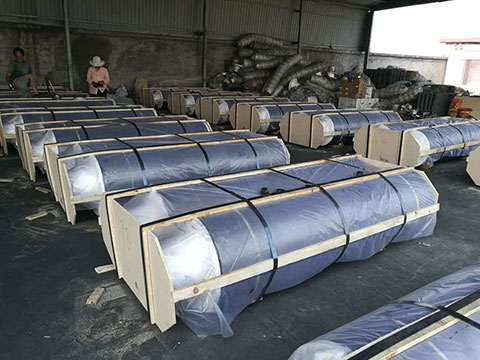Several major physical and chemical indicators are controlled within a certain range. It is not that the higher a certain indicator is, the better. In a certain sense, stability is more important than improvement. China’s rp graphite electrode industry-standard stipulates that the resistivity standard of 400~500mm in diameter is no more than 9 Ω·m for the superior grade. The first-grade product is not more than 11 Ω·m, and it is best to be stable within the range of 7.5~9.0 Ω·m. The resistivity standard of the joint material is not more than 8.5 Ω·m, and it is best to stabilize it in the range of 6.0~7.5 Ω·m.

The resistivity of the graphite electrode is determined by the quality of the raw material and the temperature of graphitization. Therefore, it is difficult to produce large-size graphite electrodes using small and medium-sized graphitization furnaces with low current density to produce products with low resistivity. Foreign countries mainly produce high-power and ultra-high-power graphite electrodes. The resistivity of the electrode body is required to be lower than 6-7Ω·m, and the resistivity of the joint blank is lower than 5Ω·m. For this reason, the graphitization temperature of the electrode body reaches 2800°C, and the resistivity index can be higher when producing high-power graphite electrodes, but it is necessary to ensure that more than 95% of them meet the quality standard. The graphitization temperature of the electrode body should also reach 2500 degrees Celsius or more, and the graphitization temperature of the bad joint material should reach 2700 degrees Celsius or more.
At present, the average temperature of graphitization furnaces in my country generally cannot reach such a high temperature, especially in factories that use small and medium-sized graphitization furnaces with low current density, most of which can only reach 2300~2500℃. Therefore, the premium grade rate of high-power graphite electrodes shipped from the factory is generally around 70%, and the actual average resistivity is close to or higher than the upper limit of the premium grade index.
The resistivity index stipulated in the quality standards of foreign products is similar to that of our country, but the resistivity measured by the physical object is much lower than the stipulated index. For example, the resistivity sample of the high-power graphite electrode joint produced by a Japanese carbon company is specified not to be greater than 6.5Ω·m, and the actual resistivity is below 5Ω·m. If it can be ensured that the resistivity of each joint is lower than that of the connected electrode, there will be no abnormal state where the temperature of the joint connection area is much higher than the temperature of the electrode body, and the joint linear expansion is greater than the electrode body linear expansion. The phenomenon of breaking at the junction of the two electrodes can be significantly reduced (other factors such as processing quality are not considered here). This breaking loss often accounts for 10% to 20% of electrode consumption in Chinese electric furnace steel plants.
To learn more about the product knowledge of graphite electrodes, please leave a message on our website.

